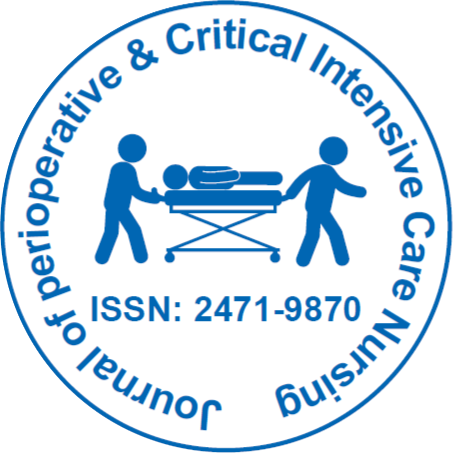
Journal of Perioperative & Critical Intensive Care Nursing
Open Access
ISSN: 2471-9870
+44-77-2385-9429

ISSN: 2471-9870
+44-77-2385-9429
Perspective - (2024)Volume 10, Issue 1
Infection control is a critical component of healthcare delivery, encompassing measures and protocols aimed at preventing the spread of infectious diseases within healthcare settings. From hospitals and clinics to long-term care facilities and outpatient centers, infection control practices play a vital role in safeguarding the health and safety of patients, healthcare workers, and visitors. This explores the importance of infection control, key strategies for preventing healthcare-associated infections, and the role of healthcare providers in mitigating the risk of transmission [1].
The significance of infection control
Infections acquired in healthcare settings pose a significant threat to patient safety and contribute to increased morbidity, mortality, and healthcare costs. Healthcare-Associated Infections (HAIs) can result from a variety of factors, including invasive procedures, contaminated equipment, improper hand hygiene, and transmission from healthcare workers or other patients [2].
Effective infection control measures are essential for preventing HAIs and minimizing the risk of outbreaks within healthcare facilities. By implementing evidence-based practices and adhering to strict protocols, healthcare providers can reduce the transmission of pathogens, protect vulnerable populations, and promote a safe and healthy environment for patients and staff [3].
Key strategies for infection control
Hand hygiene: Proper hand hygiene is one of the most effective measures for preventing the spread of infections. Healthcare providers should perform hand hygiene using soap and water or alcohol-based hand sanitizer before and after patient contact, after removing gloves, and after touching potentially contaminated surfaces [4].
Personal protective equipment: Healthcare workers should use appropriate PPE, such as gloves, masks, gowns, and eye protection, when providing care to patients with known or suspected infectious diseases. PPE helps to prevent exposure to pathogens and reduces the risk of transmission to others [5].
Environmental cleaning and disinfection: Routine cleaning and disinfection of patient care areas, equipment, and high-touch surfaces are essential for preventing the spread of infections. Healthcare facilities should follow standardized protocols for cleaning and disinfection, using EPA-approved disinfectants and ensuring proper ventilation in patient care areas [6].
Transmission based precautions: In addition to standard precautions, transmission-based precautions are used to prevent the spread of specific pathogens, including airborne, droplet, and contact precautions. Precautions involve additional measures such as patient isolation, room ventilation, and the use of specialized PPE to minimize the risk of transmission [7].
Antibiotic stewardship: Antimicrobial resistance is a growing public health concern, fueled in part by the overuse and misuse of antibiotics. Antibiotic stewardship programs promote the judicious use of antibiotics, reducing the risk of antibiotic-resistant infections and preserving the effectiveness of these life-saving medications [8].
Surveillance and monitoring: Ongoing surveillance and monitoring of HAIs are essential for identifying trends, detecting outbreaks, and evaluating the effectiveness of infection control measures. Healthcare facilities should implement robust surveillance systems to track infection rates, monitor antibiotic use, and identify areas for improvement [9].
The role of healthcare providers
Healthcare providers play a central role in infection control efforts, as they are responsible for implementing and adhering to infection control protocols in their daily practice. Providers should receive training and education on infection control principles, including proper hand hygiene, PPE use, and environmental cleaning procedures.
Additionally, healthcare providers should be vigilant in identifying patients at risk for HAIs and implementing appropriate prevention measures. This may include screening patients for infectious diseases, isolating patients with known or suspected infections, and following recommended precautions when caring for patients with communicable diseases.
Furthermore, healthcare providers should serve as role models for infection control practices, demonstrating proper hand hygiene, PPE use, and adherence to infection control protocols to their colleagues and peers. By leading by example, healthcare providers can foster a culture of safety and accountability within their healthcare facilities [10].
Challenges and future directions: While significant progress has been made in infection control, several challenges remain, including the emergence of multidrug-resistant organisms, limited resources in healthcare settings, and the global threat of infectious disease outbreaks. Addressing these challenges requires a collaborative effort involving healthcare providers, policymakers, public health agencies, and the community at large.
Moving forward, efforts to enhance infection control should focus on improving surveillance and monitoring systems, implementing innovative technologies for disinfection and sterilization, and promoting a culture of safety and accountability among healthcare providers. Additionally, investment in research and development of new antimicrobial agents and vaccines is critical for combating emerging infectious threats and reducing the burden of HAIs.
Infection control is a cornerstone of healthcare delivery, essential for preventing the spread of infectious diseases and protecting the health and safety of patients, healthcare workers, and the community. By implementing evidence-based practices and adhering to strict protocols, healthcare providers can minimize the risk of HAIs, reduce healthcare costs, and improve patient outcomes. As healthcare continues to evolve, the importance of infection control cannot be overstated, underscoring the need for ongoing vigilance, innovation, and collaboration in safeguarding public health.
[Crossref] [Google Scholar] [PubMed]
[Crossref] [Google Scholar] [PubMed]
[Crossref] [Google Scholar] [PubMed]
[Crossref] [Google Scholar] [PubMed]
[Crossref] [Google Scholar] [PubMed]
[Crossref] [Google Scholar] [PubMed]
[Crossref] [Google Scholar] [PubMed]
[Crossref] [Google Scholar] [PubMed]
[Crossref] [Google Scholar] [PubMed]
[Crossref] [Google Scholar] [PubMed]
Citation: Fpca D (2024) Safeguarding Healthcare Spaces and Effective Infection Control Practices. J Perioper Crit Intensive Care Nurs. 10:236.
Received: 20-Feb-2024, Manuscript No. JPCIC-24-30527; Editor assigned: 22-Feb-2024, Pre QC No. JPCIC-24-30527 (PQ); Reviewed: 07-Mar-2024, QC No. JPCIC-24-30527; Revised: 15-Mar-2024, Manuscript No. JPCIC-24-30527 (R); Published: 22-Mar-2024 , DOI: 10.35248/2471-9870.24.10.236
Copyright: © 2024 Fpca D. This is an open-access article distributed under the terms of the Creative Commons Attribution License, which permits unrestricted use, distribution, and reproduction in any medium, provided the original author and source are credited.